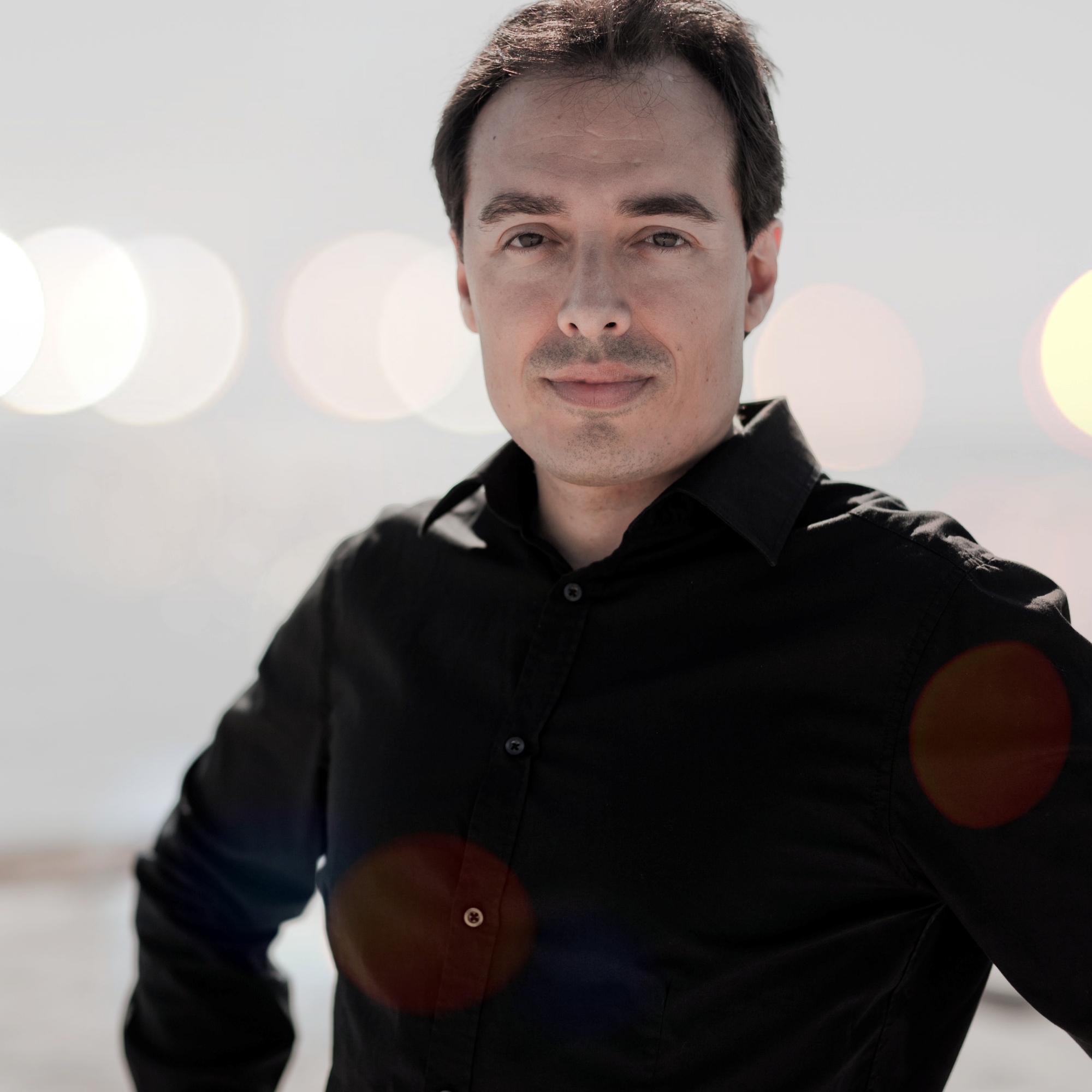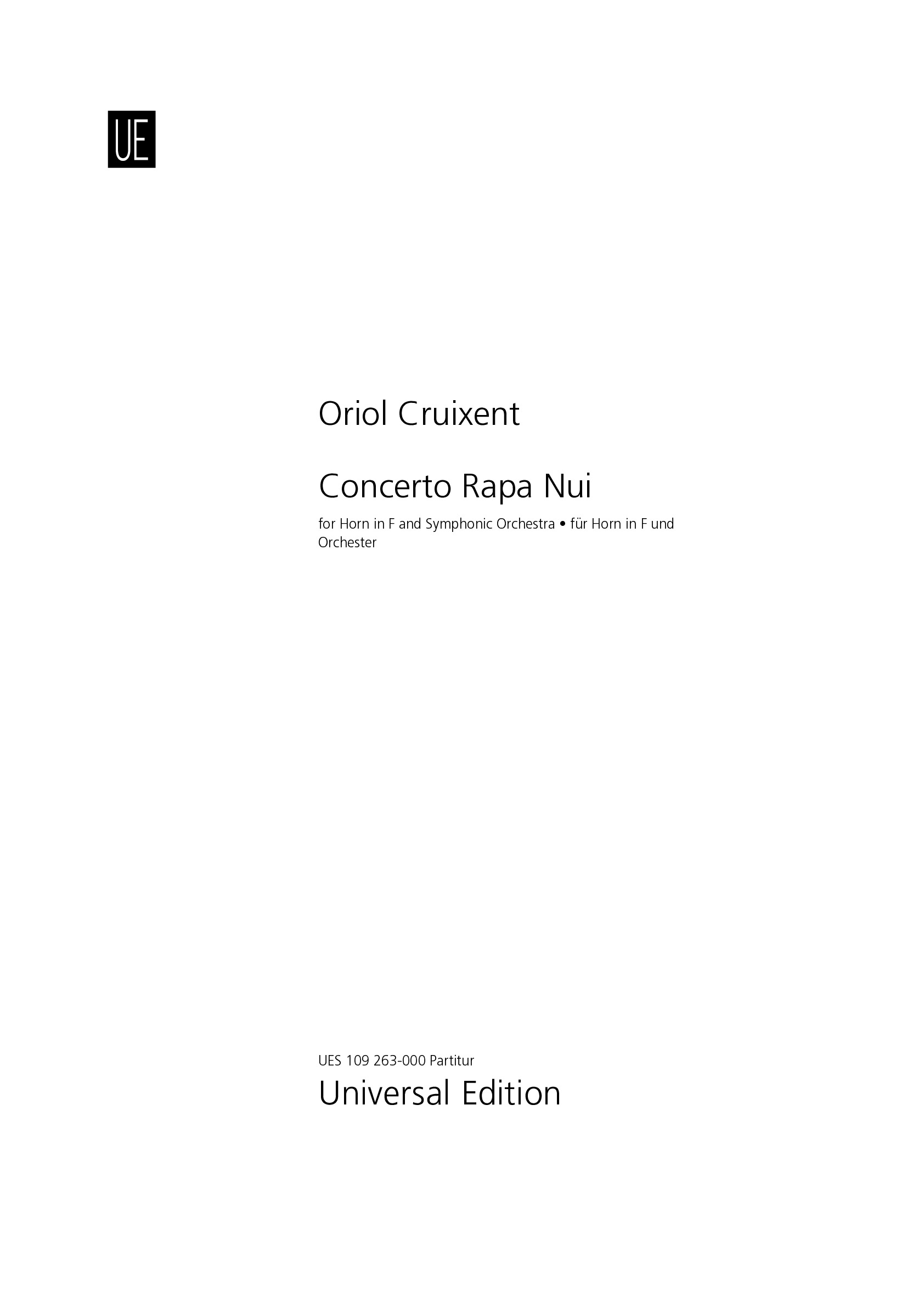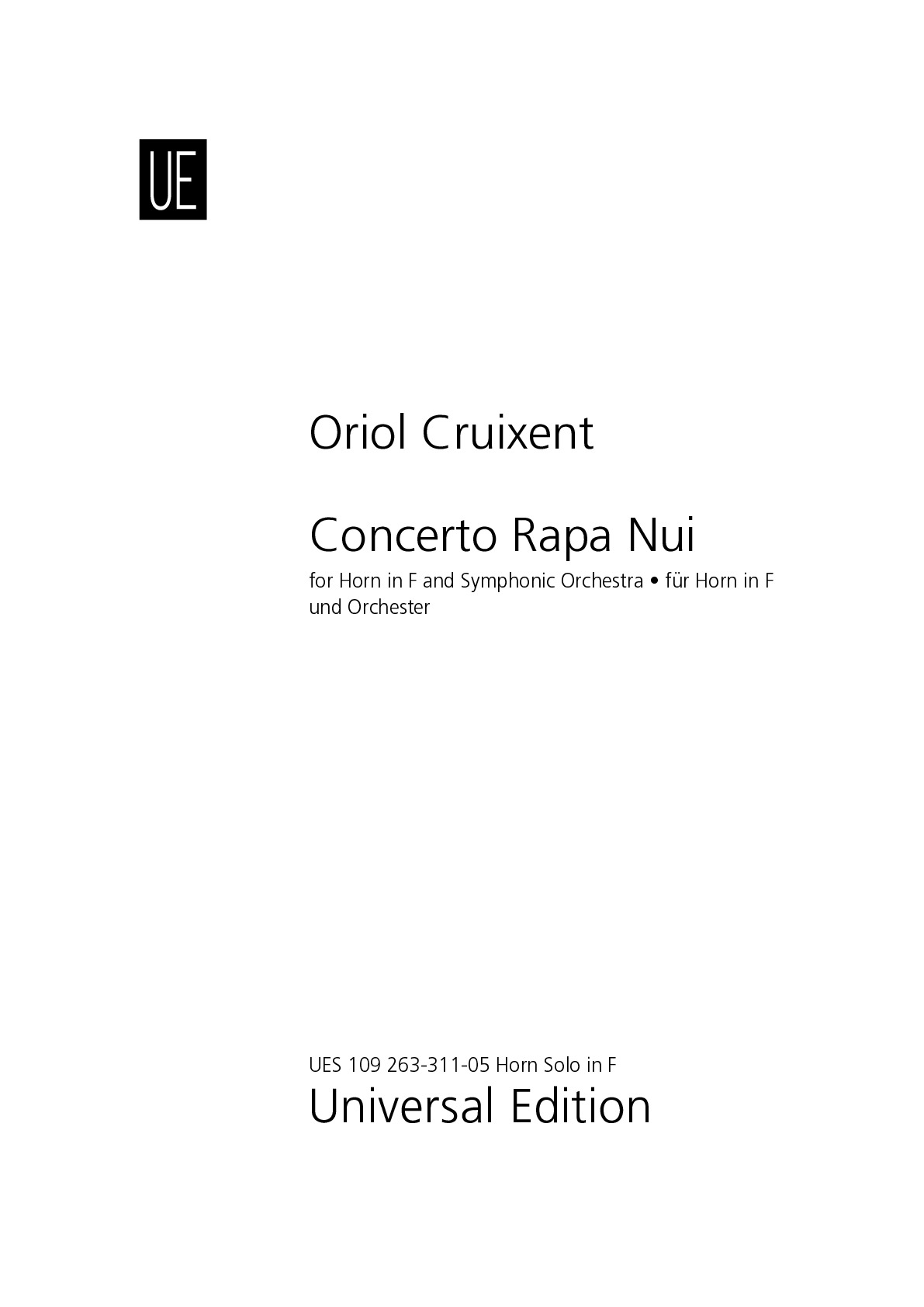

Oriol Cruixent
Concerto Rapa Nui
Short instrumentation: 3 3 3 3 - 4 2 3 1, timp, perc(5), hp, str
Duration: 22'
Solos:
horn in F
Instrumentation details:
1st flute
2nd flute
piccolo
1st oboe
2nd oboe
cor anglais
1st clarinet in Bb
2nd clarinet in Bb
bass clarinet in Bb
1st bassoon
2nd bassoon
contrabassoon
1st horn in F
2nd horn in F
3rd horn in F
4th horn in F
1st trumpet in C
2nd trumpet in C
1st trombone
2nd trombone
bass trombone
tuba
timpani
1st percussion
2nd percussion
3rd percussion
4th percussion
5th percussion
harp
violin I (16 players)
violin II (14 players)
viola (12 players)
violoncello (10 players)
double bass (8 players)
Concerto Rapa Nui
Printed/Digital
Translation, reprints and more

Oriol Cruixent
Concerto Rapa NuiOrchestration: for Horn in F and Symphonic Orchestra
Type: Dirigierpartitur (Sonderanfertigung)

Oriol Cruixent
Horn in F (Concerto Rapa Nui)Type: Solostimme(n) (Sonderanfertigung)
Sample pages
Work introduction
Concerto Rapa Nui (from the Rapanui language: literally "Big Rapa", big island, currently known as Easter Island), is a musical composition for solo horn and symphony orchestra structured in three movements. Concerto Rapa Nui proposes a musical tribute to one of the most ancient cultures on the planet and is inspired by legends of the natives of Easter Island that have survived to this day. But beyond the tribute, Concerto Rapa Nui also wants to be a space to raise awareness about the importance of respecting and preserving cultures and languages in danger of extinction.
For the creation of Concerto Rapa Nui, Oriol Cruixent uses harmonic, rhythmic and melodic rotational movements to weave the entire structure of the work, as well as two popular melodies preserved thanks to the oral tradition of generations of islanders: the song Me maorio tu collu, which tells the story of the construction and carving of the Moais, and the Hymn to Hotu Matu'a, which tells of the legend of the journey undertaken by King Ariki Hotu Matu'a after dreaming that his island (Hiva) would be flooded, setting out with seven explorers to discover a new place to live.
The composition envisages that both melodies can be sung in the Rapa Nui language by the soloist himself. In addition, during the performance of the song Me maorio tu collu, present in the second movement, a small choir of indigenous can optionally be added, led by the soloist from one end of the stage to the other, thus embodying the vision of Te Tokanga, the stone giant (see below).
The three-movement musical journey of the Concerto Rapa Nui composition takes place in five specific places on Easter Island:
Prelude: Ahu Huri a Urenga (The Astronomer): The Ahu Huri a Urenga is a platform located in the interior of the island, which supports a single moai with 4 hands and was used as a solar observatory. Both the platform and the moai face exactly towards the sunrise during the southern winter solstice.
I: Ahu Nau Nau (Anakena): It was here that, according to oral tradition, the first king of the island, the Ariki Hotu Matu'a, landed with his men and established the first settlement that gave rise to the Rapa Nui culture. This is an Ahu with seven moai, probably paying homage to those same seven explorers. In this movement we hear the first stanza of the Hymn to Hotu Matu'a.
II: Te Tokanga (The Giant): The moai Te Tokanga is the largest moai in Rapa Nui and still lies in the quarry on the southern slope of the Rano Raraku volcano, the origin of most of the stone statues carved on Easter Island. It was never finished. During this movement we hear the song Me maorio tu collu, which tells the story of the construction and carving of the moai.
Cadenza: Te Pito Kura (navel of light): In the archaeological complex of Te Pito Kura, you can find a strange stone with magnetic properties surrounded by legends and the origin of mana, the spiritual energy of Rapa Nui.
III: Ahu Akivi: Ahu Akivi is a particular sacred place in Rapa Nui. It has seven statues and is the only ahu with moai facing the ocean. There are rumors among certain Rapa Nui families that the seven statues of Ahu Akivi represent the seven explorers sent by King Hotu Matu'a to find Rapa Nui a thousand years ago. According to these rumors, the moai are facing the place where the Rapa Nui people once came from. A particular feature of the seven identical moai statues is that they face exactly the sunset during the spring equinox and have their backs to the sunrise during the autumn equinox.
The work Concerto Rapa Nui was finished in November 2024, commissioned by Chilean horn player Matías Piñeira and dedicated to him.
What is necessary to perform this work?
INSTRUMENTATION
SYMPHONIC ORCHESTRA
2 Flutes
1 Piccolo Flute
2 Oboes
1 English Horn
2 Clarinets in Bb
1 Bass Clarinet in Bb
2 Bassoons
1 Contrabassoon
4 Horns in F
2 Trumpets in C
2 Trombones
1 Bass Trombone
1 Tuba
Timpani
Percussion (5 players)
Perc. 1: Whirly Tube in Eb (Corrugaphone) in black or grey colour (around 1 meter long)
Vibraphone
Hand Stones (two smooth river rocks of similar size; hit one against the other)
Shekere
China Opera Gong 10,5"/27cm (downwards glissando)
Perc. 2: Whirly Tube in Eb (Corrugaphone) in black or grey colour (around 1 meter long)
Hand Stones (two smooth river rocks of similar size; hit one against the other)
Chains (old prisoner chains)
Set-Up 1 (shared with Perc. 3): 7x Drums (e.g. 6 Tom-toms + G.C.)
Perc. 3: Whirly Tube in Eb (Corrugaphone) in black or grey colour (around 1 meter long)
Set-Up 1 (Shared with Perc. 2): 7x Drums (e.g. 6 Tom-toms + G.C.)
China Opera Gong 12"/30cm (downwards glissando)
C-Marimba (5-octave)
Perc. 4: Whirly Tube in Eb (Corrugaphone) in black or grey colour (around 1 meter long)
Hand Stones (two smooth river rocks of similar size; hit one against the other)
Set-Up 2: 1x drum (middle-low), Ride, Hi-Hat, Crash, Crasher and China-Cymbals
Chains (old prisoner chains)
Perc. 5: Whirly Tube in Eb (Corrugaphone) in black or grey colour (around 1 meter long)
Set-Up 3: 4x Drums (e.g. 3 Daikos and 1x Low Drum)
China Opera Gong 11"/28cm (downwards glissando)
Chains (old prisoner chains)
Harp
Strings (16-14-12-10-8)
FRENCH HORN SOLO in F (During the "Prelude" and the second part of the "Cadenza", if available, use an ancestral instrument such as a Conch Shell or a Carnyx, tuned in Eb)
